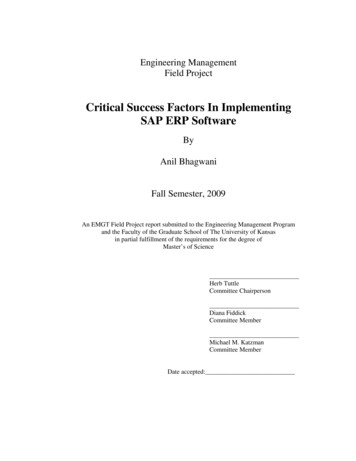
Transcription
Implementing an Effective Faraday CageAdam McHale
1. Function of the Faraday CageA Faraday Cage operates to protect an object or series of contents fromstray electromagnetic waves. This is done by placing anelectromagnetic-sensitive device inside a container constructed ofconductive metal.Picture 1: A Faraday Cage protecting a device from EM interferenceIn the presence of an external electric field, the charges within theconductive material of the Faraday Cage redistribute themselvesappropriately under the effect of the external field.The then rearranged charges induce an electric field in directionalopposition to the applied external field, negating its magnitude.The net impact is an electromagnetically-neutral volume of the FaradayCage.
2. Selecting MaterialsConstruction of a Faraday Cage requires several materials. The qualityand magnitude of such materials will vary depending on the intent ofthe established Faraday Cage.A sealable container must be appropriately chosen such that it mayfully contain the desired contents of the Faraday Cage. MinorInconsistencies in the shape and structure of the container areacceptable as the container will be sheltered in conductive material.A conductive material with the capability of surrounding thedetermined container is also necessary.Picture 2: Simple materials for a small-scale Faraday Cage
3. Quality of Conductive MaterialThe electromagnetic characteristics of the conductive material are onlyrequired to be capable of carrying charges while under the presence ofa field of specified magnitude.To this end, Silver is one of the most conductive materials available, butcan be quite costly. Aluminum is much more accessible and managessufficient conductivity.Under the presence of an external electric field, charges becomeredistributed throughout the conductive material so that like chargesare pushed away from the source of the electric field, while oppositecharges are attracted.In this way, charges are separated so that they form an electric field inopposition to the applied one.Picture 3: Depiction of the effect of conductive shielding
4. Construction of the Faraday CagePicture 4: Container shielded with conductive materialBy wrapping the container in the chosen conductive material, thecontents of the container will be fully shielded. This has the sameeffect as simply constructing a container out of a sufficiently conductivematerial altogether.When an external electric field is now applied across the container, thecharges within the conductive material will be distributed in a way suchthat their counteracting electric field yields an electro-magneticallyneutral area on the inside of the container.
5. Testing the Faraday CageTesting the Faraday Cage is simple. Since any externally appliedelectromagnetic fields should be nullified within the container, suchelectromagnetic fields should not be detectable.A simple test may be done with a cell phone. If the Faraday Cage hasbeen constructed effectively, the cell phone should not be able toreceive calls as any incoming electromagnetic fields should be negatedby the Faraday Cage.For large-scale testing, such as determining immunity to EMPdisruption, high-magnitude waves in an array of frequencies would benecessary to test sufficient isolation performed by the Faraday CageFigure 5: Walky-talkies within a Faraday Cage
our-own-faraday-cage-hereshow/
A Faraday Cage operates to protect an object or series of contents from stray electromagnetic waves. This is done by placing an electromagnetic-sensitive device inside a container constructed of conductive metal. Picture 1: A Faraday Cage protecting a device from EM interference In the presence of an external electric field, the charges within the conductive material of the Faraday Cage .











